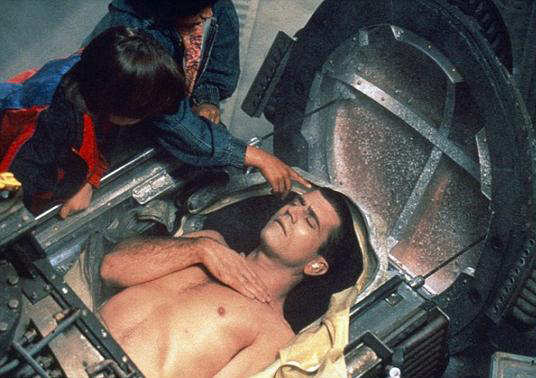Summary:
Life, old age, sickness and death are natural laws, but there are always people who are dedicated to bringing the dead back to life at all times and in all countries. In the science fiction film Youth Forever starring Mel Gibson, the hero once participated in a freezing plan. He was frozen for a year, but was unexpectedly frozen from 1939 to 1992
Life, old age, sickness and death are natural laws, but there are always people who are dedicated to bringing the dead back to life at all times and in all countries.
In the science fiction film "Youth Forever" starring Mel Gibson, the hero once participated in a freezing plan. He was frozen for a year, but unexpectedly was frozen from 1939 to 1992 before waking up. It became the most dramatic turning point of the film.
In the play, the concept of "bringing the dead back to life" by means of freezing technology comes from the concept of human body freezing technology in the scientific community. Cryonics, also known as human refrigeration, is a kind of medical science and technology under test, which can refrigerate human or animals at extremely low temperatures (below - 196 degrees Celsius). It is a dream that in the future, people can "resurrect" after thawing through advanced medical technology.

Robert, 80, the pioneer of the world's first case of human body freezing Robert Nelson has always believed that freezing technology can bring people back from the dead (hence the "liar" curse). Just this year, Nelson said that the first person he had frozen with liquid nitrogen 50 years ago could be brought back to life immediately. He is convinced that the freezing technology has worked, and he is planning his second experiment.
Robert, born in Boston in 1936 Nelson, early life was not good. At that time, the economy was depressed. His father left before he was born. His mother remarried five years after his father left. She smoked and drank everything, but did not care much about Nelson. The stepfather was also a small gangster. Later, the stepfather went to prison, and even the stepfather's son went to prison. Nelson said that his father had always been in prison, which made him feel like he had a fake father.
However, the miserable life does not affect his own life path. Before he finished high school, he became an electrician. In 1965, when Nelson, 29, moved to Los Angeles, California, he first came into contact with human body freezing technology.
Nelson's understanding of cryoscience comes from Robert, the father of human body cryonics Dr. Robert Ettinger's 1962 book The Foreground of Immortality. In this book, Ettinger proposed that "suspended animation is a kind of science, but its potential feasibility has not been found." And he believed that death did not happen suddenly, but was a gradual process.
"If the body is frozen fast enough, death can be reversed."
He used a lot of research data to show that it is possible to freeze and revive life. Many insects and lower animals in nature have the function of reviving frozen life. Therefore, Dr. Ettinger believes that advanced animals, including people, can use this method to extend their lives as long as they master the mysterious laws!
Nelson liked the idea very much, so he bought his book, which made him think more about human body freezing.
At the same time as Nelson, James Bedford, a professor of psychology, was the first person in the world to be completely frozen. When Bedford finished reading this book, he was convinced by the ideas in the book and kept correspondence with the author, Dr. Ettinger.
The first person in the frozen world, psychology professor James Bedford
By the end of 1966, Nelson, who had further deepened his knowledge of human freezing, had become the chairman of the local Life Extension Association. He was invited to Los Angeles to talk with the members of the group, and then met the hero of his life, Ettinger. He became Ettinger's best helper.
At this time, Bedford is also writing to Professor Ettinger about Professor Ettinger's book and his own cancer, and is considering freezing. But no one has ever been frozen before.
Although Bedford didn't want to be the first person to be frozen, he was close to death at that time. If he didn't freeze, it would mean complete death, so he decided to freeze it for a try - also because he was a very rich man, and his wealth could afford the high cost of freezing technology at that time.
Nelson said: "At that time, I had to see Bedford before he died. So I went to the hospital. I hope Bedford is in a coma, but he is sober, so I introduced myself.
Bedford told Nelson before his death that he had no hope that he would be resurrected one day, but he did so anyway. It is hoped that this incredible science will benefit his children and grandchildren one day in the future.
Two days later, in the evening of January 12, 1967, 72 year old psychology professor James Bedford died of stomach cancer in a hospital bed in Glendale, California, which is not unusual. But what happened next was too rare.
Nelson, a retired electrician who has not graduated from high school, and Dante, an Italian biologist Dr. Dante Brunol, a chemist in Santa Barbara, California Robert Prehoda formed a three person team to implement the frozen Bedford procedure.
Just after Bedford's death, the three person team conducted experiments on his body. This experiment means that he will soon become the first human being to be cryopreserved in the world.
They first cooled Bedford with ice, drained his blood, and replaced him with "biological antifreeze" (DMSO), then packed him in a box. However, the three suddenly realized that there was no place to store Bedford's body, because the cryogenic "capsule" belonging to Bedford was still under construction in Arizona.
As a result, how did Bedford spend the first two weeks after his death?
Nelson called his friend and said he was in trouble and needed help. His friend asked, "What's the difficulty?" Nelson said, I have this frozen guy, and I want to find a place to keep it for two or three weeks. Then the friend said, "No problem, can you still be a friend without helping me? Bring him here!"
So Nelson and others transported Bedford away through the pickup truck and hid him in a garage in Topanga Canyon, Los Angeles.
In retrospect, Nelson walked along these incredible roads through Topanga Canyon and carried a frozen corpse in a pickup truck. He felt that when he was young, he must be crazy to have the courage to do so.
About two weeks later, the capsule for Bedford was completed. Nelson took his body to Arizona and finally put him in a "capsule".
They wrapped Bedford's body in a polyester sleeping bag, fixed it on a stainless steel stretcher, and put it into a capsule.
Bedford's cryopreservation was successful, but then, there were other people who wanted to participate in the cryopreservation plan, and they were not so lucky. The effect of cryopreservation was not very good - leading to Nelson being sued again and again in the next ten years, losing 400000 dollars.
Among the nine patients involved later, the first woman who was cryopreserved was 74 year old Marie Sweet. An early fan of the freezing method, she "volunteered" to be frozen. It's only seven months since Nelson first performed freezing.
Nelson held another "patient" photo in his seaside home in California: Mary Sweet, who was the first woman to be frozen.
However, the fact proved that the freezing technology was still a mistake at that time. Because many families who wanted to freeze later were unable to pay for the corpse of the patient they wanted to maintain. When the money supporting their freezing ran out, Nelson was forced to let some corpses decompose.
It never rains but it pours. At the beginning of 1979, Michael Worthington, a lawyer, sued Nelson, claiming that he was suspected of fraud and breach of contract. He also believed that Nelson had tricked refrigeration technology into a new religion - trying to bring back the dead. But so far, he has obviously failed to do so.
Nelson was very upset at such a thing. He reflected that "every step has problems. Once a week, we must use a large pump and pump water out there, so we can get down there and replace the ice. The biggest problem is that the replacement of liquid nitrogen and dry ice is not in place."
So he put down his work, ran to the desert alone, held a ceremony, said goodbye to those who failed to freeze, and told himself that he could do better.
Nelson's hard struggle was not helped by the scientific community and the media. In this case, Nelson and his friend Kloster were found guilty and fined 400000 dollars.
Two years later, another person involved in the freezing died, and her son later sued Nelson.
After that, Nelson's reputation was ruined. He decided to "wash his hands in a golden basin" and stop freezing his body. And he decided not to do anything in this new discipline at that time.
In those frustrated days, he divorced his first wife, met his second wife and got married.
Time has changed. When he retired, he changed his mind and decided to re study human body freezing technology. In 2014, he also published his memoir, Easy or Hard to Freeze People.
Now his experience will also be made into a movie, starring "Ant Man" Paul Paul Rudd. He was happy to see a movie about his life - he said he would be frozen one day.
He hoped that if he could bring himself back to life, the first thing he would do when he woke up was to see what kind of room he stayed in, because he had stayed in the capsule before. Nelson said: "It is only a matter of time. Science can certainly make resurrection possible."
Escaping death is an eternal dream of mankind. Human body freezing may be the closest technology to this dream at present. As Nelson said, "I don't believe in immortality, but I believe that life can be extended. Early people can only live to be in their twenties. Today, it is normal to live to be 100. There is no doubt that science is making progress."
Finally, do you remember the first person who was frozen 50 years ago, the millionaire Bedford? He is still sleeping soundly in the cryogenic tank liquid nitrogen in Scottsdale, Arizona, waiting for the day in the future when advanced science and technology will "awaken" him.









